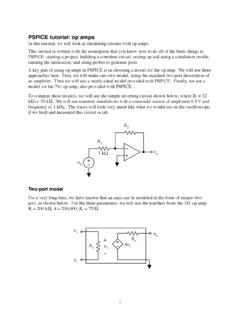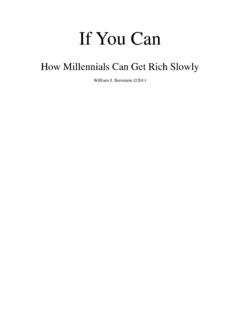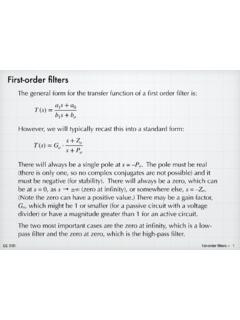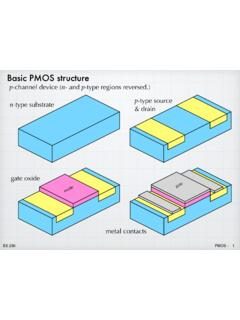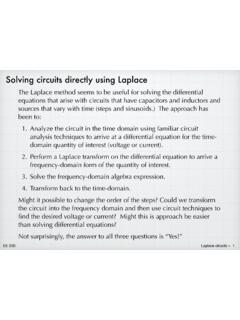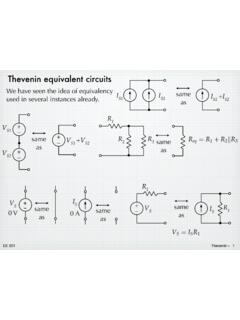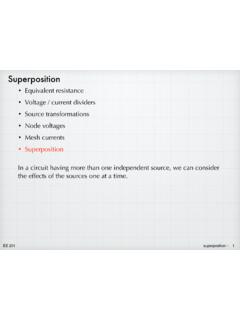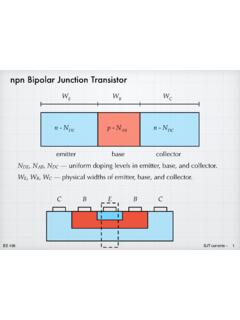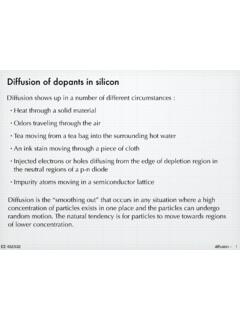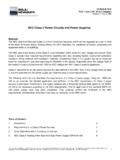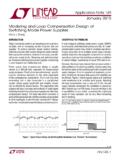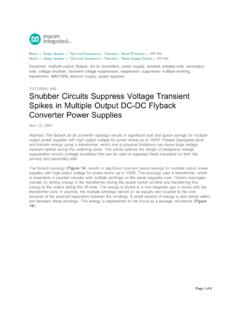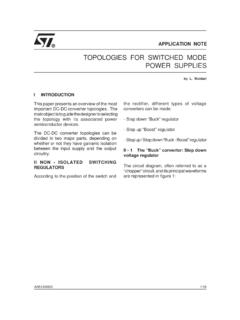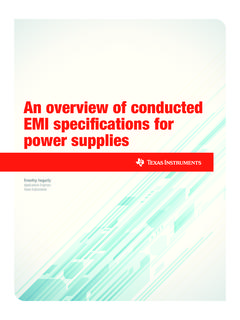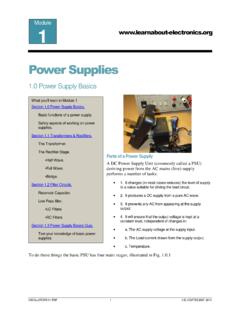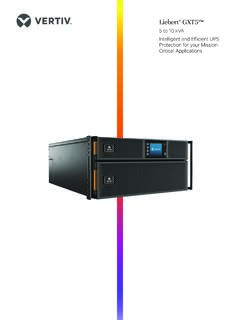Transcription of Rectifier circuits & DC power supplies
1 EE 201rectifiers 1 Rectifier circuits & DC power suppliesGoal: Generate the DC voltages needed for most electronics starting with the AC power that comes through the power VRMS9DF=( 9)sin 7W f = 60 Hz(T = ms)How to take time-varying voltage with an average value of 0 and turn it into a DC voltage?EE 201rectifiers 2peak rectifiertransformerregulatorDC load120 VRMS transformer : reduces AC amplitude to something safe and manageable. Vpeak from the transformer will be a few volts bigger than the desired DC rectifier : breaks up the AC waveform and produces a VDC Vpeak .regulator : Refines the output of the rectifier. (optional)Issues: Total power Efficiency Cost Load regulation (Does VDC change as the load draws different amounts of current?) Line regulation (Does VDC change if the input AC amplitude changes?)
2 EE 201rectifiers 3 Half-wave rectifier+ vR+VS96(W)=9 Ssin 7W Vp = 3 flows when diode is in forward conduction. The output tracks the input during positive half represent a load. We are trying to deliver DC power to the is off until VS > 201rectifiers 4Y5(W) 9 Ssin 7W . 9VS > 0:VS < 0:vR(t) = 0:To get the negative half of the cycle, turn the diode diode turns off when VS < V. It stays off during the negative half cycle of the (DYJ) 93 . 9 0 !EE 201rectifiers 5 Time delayNote that since the diode will not turn on until the sinusoid goes above V, there is time delay before the rectifier turns on . It is a simple matter to determine the delay time, using the on-off diode model: . 9=9 Ssin 7W W =7 arcsin . 99S If f = 60 Hz (T = ms) and Vp = 3 V, t = , Vo (V)timediode initially offoutputfollowsinputdiode off againThere is a similar time offset at the other end of the positive half effect of the time offset become negligible if VP >> 201rectifiers 6 Peak rectifierAdd a largish capacitor after the diode, in parallel with the , diode is on & cap charges to VP - VS < vC , diode is off!
3 Cap discharges through load.+ vR+VSCiDiRiC+ vR+VSCiCiREE 201rectifiers 7 Diode stay off until VS comes back around and becomes bigger than vC. Then diode comes on again and re-charges the capacitor.+ vR+VSCiDiRiCWhen VS falls to less than vC, the diode turn off again, and the cycle 201rectifiers 89R(PD[)=93 . 99R(PLQ)=[93 . 9]exp W 5& [93 . 9]exp 75& 9 ULSSOH=9R(PD[) 9R(PLQ)=[93 . 9] exp 75& 9R(DYJ) 9R(PD[) 9 ULSSOH 0t10Tt1 = time when diode conducts TNot a a perfect DC voltage at output. There is some variation (ripple) around an average 201rectifiers 9 Example 1C = 100 FR = 5000 !96=( 9)sin 7W T = msFind the average value of vo and the ripple voltage. Repeat for R = 1000 ! and 200 !.+ vo+VSC9 ULSSOH=[93 . 9] exp 75& = V R = 1 k!Vripple = VVo (avg) = VR = 200 !Vripple = VVo (avg) = V=[ 9.]]]]
4 9] exp . PV( )( )) 9R(DYJ)=9R(PD[) 9 ULSSOH = . 9 . 9 = . 9 Drawing more current causes the ripple to increase and VDC to droop. Can fight this with more 201rectifiers 10 Example 2R = 1000 !T = msFind the capacitance so that the ripple will be no bigger than 1 V.+ vo+VSC9 ULSSOH=[93 . 9] exp 75& 96=( 9)sin 7W = 397 F= . PV ln 9 . 9 &= 75 ln 9 ULSSOH93 . 9 What is the DC voltage?9R(DYJ)=9R(PD[) 9 ULSSOH = . 9 9 = . 9 What capacitance is needed to limit the ripple to V?C = 4000 F !!!EE 201rectifiers 11 Full-wave rectifierWith a few more diodes, we can rectify the entire sinusoidal input.+ vR+VS1234+ +vR 1234 VSorThe diodes are in a bridge the positive half cycle of the input, diodes 1 and 2 will be forward biased. Current will flow from the positive source through those diodes and the resistor to generate a positive voltage across the the negative half cycle of the input, diodes 3 and 4 will be forward biased.]
5 Current will flow from the negative source through those diodes and the resistor to generate a positive voltage across the resistor, 201rectifiers 12+ +vR 12 VSiR+ +vR 34 VSiRNote that there are no two diode drops in the conduction path(s).Also, the frequency is effectively 201rectifiers 13 Full-wave peak rectifierPlacing a capacitor in parallel with the load, turns the circuit into a full-wave peak rectifier. It behaves essentially the same as the half-wave peak rectifier except with twice the frequency (half the period).+ vR+VS1234 CRThe ripple voltage is calculated in exactly the same way, except that the period is cut in half (frequency doubled).9 ULSSOH=[93 . 9] exp 7 5& Same as doubling capacitance!96(W)=9 Ssin 7W Vp = 8 201rectifiers 14 Example 3 You want to use a wall transformer that produces 10-VRMS at the secondary to generate a DC voltage.
6 The desired voltage DC should be greater than 12 V and it should be able to supply at least 50 mA while keeping the voltage ripple to less than 5%. Design the rectifier to meet these goals. (Note: f = 60 Hz.)Two options: half-wave or full-wave rectifier. Try VRMS V amplitudeHalf-wave:Vo(max) = Vp V = V Vripple RL Vo / Io = V / (50 mA) = 240 !&= 75 ln 9 ULSSOH93 . 9 = 1350 F Note: This would be the minimum value of effective resistance. If we choose C to meet the ripple requirement, then we will still be safe if we use a slightly higher Vo. Vo(avg) = Vo(max) Vripple / 2 = 201rectifiers 15 Full-wave:Vo(max) = Vp 2( V) = V Vripple (avg) = Vo(max) Vripple / 2 = 7 5 ln 9 ULSSOH9R(PD[) = )Either approach will work and meet the requirements. The full-wave version uses extra diodes, but only half the capacitance.]
7 Since diodes are nearly free (pennies per piece), but big capacitors are relatively expensive, the full-wave circuit will actually cost less than the half-wave. This is why full-wave rectifiers are used more commonly than half-wave manufactures supply full-wave bridge rectifiers packaged as single unit with the transformer sinusoid as input the rectified waveform as the output.
